|
|
| |
 |
|
| |
 Fancy
tweeds and evening fabrics. Eaton's Spring/Summer Catalogue, 1903,
p. 2. Fancy
tweeds and evening fabrics. Eaton's Spring/Summer Catalogue, 1903,
p. 2.
|
|
| |
|
|
|
Custom-made to Ready-made: Women's Clothing in the
Eaton's
Catalogue, 1884 to 1930
by Christina
Bates
One hundred years ago most people made their own
clothes or
hired a tailor or dressmaker to make clothing for them. The mail-order
catalogue
was a major catalyst for the transition from custom-made to ready-made
clothing.
|
|
Introduction | "We
Supply Everything to Make Your Own" | "Or
We Will
Make It for You" | "From
Corsets
to Collars: The Cheapest and the Best" | "House
Wrappers and Tea Gowns Calculated to Fit" | "Presenting:
The Dress Shop" | Conclusion |
Further
Reading
|
Introduction
| |
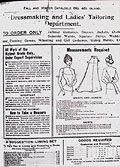 |
|
| |
 Eaton's
Fall/Winter Catalogue, 1900-01, p. 3. Eaton's
Fall/Winter Catalogue, 1900-01, p. 3.
|
|
| |
|
|
|
Imagine a clothing catalogue that has two or three drawings of the
types of
garments carried. To order a dress or suit, you are instructed to describe
what
you want: the type of garment, colour, fabric, style, and approximate
price.
You must indicate whether you are young or "matronly," and
have any
"peculiarity of shape." You also have to send in twenty
separate
measurements of your body.
One hundred years ago, you would have been thrilled! Think of the
alternative:
You would have to make the garments yourself, or pay a tailor or
dressmaker to
do so at greater cost.
Today, very few of us have our clothes designed and sewn for us
individually.
We buy garments off the rack. But, until the mechanization of the clothing
industry
in the late 19th century, garments were made by hand to fit a particular
person.
| |
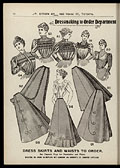 |
|
To custom-make a skirt or
waist (blouse), Eaton's required a description or illustration from the
customer. The catalogue illustrations served as inspiration. Eaton's
Spring/Summer Catalogue, 1899, p. 12.
|
 |
|
The mail-order catalogue was a major catalyst for the transition from
custom-made
to ready-made clothing. The first catalogues competed with tailors and
dressmakers
by offering made-to-order goods. Twenty years later, however, the
mail-order
companies closed their custom dressmaking and millinery workrooms and
began offering
customers ready-to-wear garments produced by machine in the growing
numbers of
clothing factories. Each step of the way, Eaton's had to reassure
its patrons
- who were accustomed to having their clothing custom-made by a
dressmaker
or tailor - that the mail-order catalogue was an acceptable
alternative.
|
"We Supply Everything to Make Your
Own"
In response to an "immense increase" in orders from
customers
through the mail, the Eaton's issued its first catalogue in 1884.
The catalogue was simply a listing of the kinds of merchandise sold in the
store:
carpets, blankets, fabric, underclothing such as corsets and crinolines,
and,
of course, clothing accessories no lady should be without: fans, gloves,
handkerchiefs,
parasols.
| |
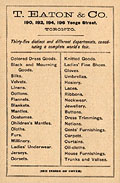 |
|
Eaton's started as a dry
goods
store, carrying fabrics, clothing accessories, and household furnishings
- as reflected in the early catalogues. Soon it would add more and varied
goods comparable to today's department store. Eaton's Fall/Winter
Catalogue,
1884, p. 34 (reprint).
|
 |
|
| |
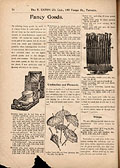 |
|
Eaton's cautioned: "A lady
will go pretty shabbily dressed before she will walk the streets on a
summer day without a parasol." Eaton's Fall/Winter Catalogue, 1893-94,
p. 76.
|
 |
|
A large part of the catalogue was devoted to "dress goods,"
or
fabrics, such as flannels, velvets, black crape (for mourning), silk and
printed
cottons; needles, thread, buttons and other sewing notions; and, dress
trimmings
such as lace and braid - everything a woman would need to make her
own
and her family's clothing. Eaton's even supplied dressmaking
patterns.
| |
 |
|
Velveteen was a luxury
fabric
used for everything from fancy boy's suits to evening gowns. Eaton's
Spring/Summer Catalogue, 1898, p. 6.
|
 |
|
Customers were instructed to describe their needs, for example,
"I want
something in gray for a travelling dress, not to exceed 75 cents a yard,
and
an idea in appropriate trimming." Eaton's would then send
samples
of fabrics and trim, from which the customer would make a selection.
| |
 |
|
Butterick was a dressmaking
pattern company and published a leading fashion magazine. Eaton's
Spring/Summer
Catalogue, 1900, p. 193.
|
 |
|
|
"Or We Will Make It for You"
Once a lady received the fabric and trim from Eaton's, she would
then
have to make the garment. Most women could make simple dresses to wear at
home.
But, if she could afford it, a lady employed a professional dressmaker to
sew
her formal costume, which, in the late 19th century, was elaborate in
construction
and materials. Usually, it consisted of a two-piece suit with a
tight-fitting
bodice adorned with braid and buttons and a multi-layered skirt draped
with fringed
velvet or silk. Ladies relied upon the special skills of dressmakers
-
or "lady tailors" as they were sometimes called - in the
fitting
and draping of the costly fabrics.
Eaton's competed for this market. In 1898, it established its
"Dressmaking
and Ladies' Tailoring Order Department" in an attempt to woo
away
customers - especially women living in small villages or in the
country
- from small dressmakers and tailors: "Ladies living in the
remotest
part of Canada have every advantage of the latest fashions as if living in
Toronto.
All work of absolutely the best quality, under the supervision of the
foremost
Modiste in Canada."
Eaton's made hats to order, as well. Since no woman would venture
outside
her home without a hat, women had to have at least two hats - one
for the
fall/winter season and one for spring/summer. The enormous hats were
supported by an intricate foundation of intersecting wires covered in
cloth and
draped with rich fabrics festooned with feathers or silk roses.
| |
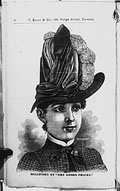 |
|
| |
 By
operating a large workroom of milliners, Eaton's was able to keep prices
down. Eaton's Fall/Winter Catalogue, 1888-89, p. 18. By
operating a large workroom of milliners, Eaton's was able to keep prices
down. Eaton's Fall/Winter Catalogue, 1888-89, p. 18.
|
|
| |
|
|
|
This essential of the lady's attire provided scores of women with
work
as milliners, or ladies' hat makers. Many milliners, like
dressmakers,
worked in small stores with one or two young apprentices. Eaton's
had its
own millinery workrooms with "an immense staff." Eaton's
reassured
possibly sceptical customers that it was appropriate to order hats by
mail: "Millinery
is easy to order by mail if you are careful in ordering. Clever clerks
devote
their whole time to anticipate the wants and wishes of mail order
customers."
| |
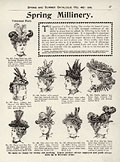 |
|
| |
 Eaton's
Spring/Summer Catalogue, 1898, p. 27. Eaton's
Spring/Summer Catalogue, 1898, p. 27.
|
|
| |
|
|
|
Customers were advised to give detailed descriptions of the style,
colour,
material, trimming, and price of hat desired, as well as details of their
age,
height, and weight. Hats were matched to body types, and presumably women
were
more honest in those days, since they were asked to state whether they
were "stout
or thin." Illustrations of sample hats in the catalogues were meant
to
give customers an idea of what Eaton's had to offer.
|
|
Page 2 >>
|
|